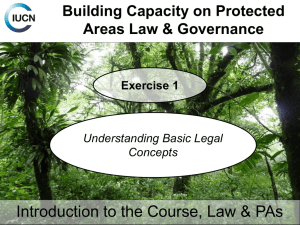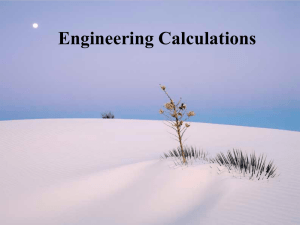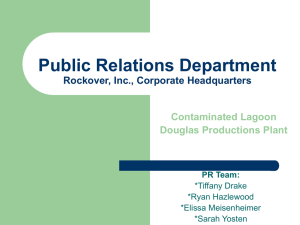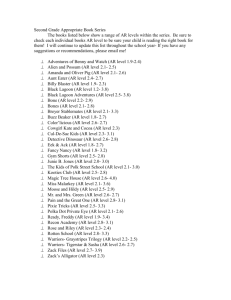Modelling of sediment dynamics and the effect of mussel
advertisement
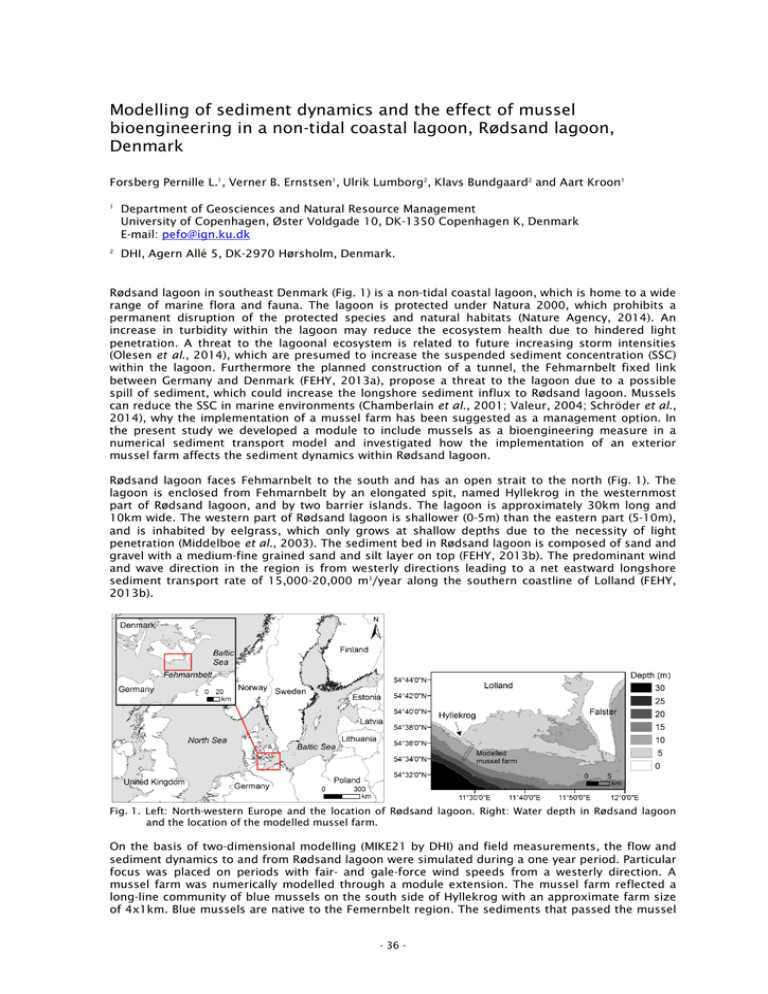
Modelling of sediment dynamics and the effect of mussel bioengineering in a non-tidal coastal lagoon, Rødsand lagoon, Denmark Forsberg Pernille L.1, Verner B. Ernstsen1, Ulrik Lumborg2, Klavs Bundgaard2 and Aart Kroon1 1 Department of Geosciences and Natural Resource Management University of Copenhagen, Øster Voldgade 10, DK-1350 Copenhagen K, Denmark E-mail: pefo@ign.ku.dk 2 DHI, Agern Allé 5, DK-2970 Hørsholm, Denmark. Rødsand lagoon in southeast Denmark (Fig. 1) is a non-tidal coastal lagoon, which is home to a wide range of marine flora and fauna. The lagoon is protected under Natura 2000, which prohibits a permanent disruption of the protected species and natural habitats (Nature Agency, 2014). An increase in turbidity within the lagoon may reduce the ecosystem health due to hindered light penetration. A threat to the lagoonal ecosystem is related to future increasing storm intensities (Olesen et al., 2014), which are presumed to increase the suspended sediment concentration (SSC) within the lagoon. Furthermore the planned construction of a tunnel, the Fehmarnbelt fixed link between Germany and Denmark (FEHY, 2013a), propose a threat to the lagoon due to a possible spill of sediment, which could increase the longshore sediment influx to Rødsand lagoon. Mussels can reduce the SSC in marine environments (Chamberlain et al., 2001; Valeur, 2004; Schröder et al., 2014), why the implementation of a mussel farm has been suggested as a management option. In the present study we developed a module to include mussels as a bioengineering measure in a numerical sediment transport model and investigated how the implementation of an exterior mussel farm affects the sediment dynamics within Rødsand lagoon. Rødsand lagoon faces Fehmarnbelt to the south and has an open strait to the north (Fig. 1). The lagoon is enclosed from Fehmarnbelt by an elongated spit, named Hyllekrog in the westernmost part of Rødsand lagoon, and by two barrier islands. The lagoon is approximately 30km long and 10km wide. The western part of Rødsand lagoon is shallower (0-5m) than the eastern part (5-10m), and is inhabited by eelgrass, which only grows at shallow depths due to the necessity of light penetration (Middelboe et al., 2003). The sediment bed in Rødsand lagoon is composed of sand and gravel with a medium-fine grained sand and silt layer on top (FEHY, 2013b). The predominant wind and wave direction in the region is from westerly directions leading to a net eastward longshore sediment transport rate of 15,000-20,000 m3/year along the southern coastline of Lolland (FEHY, 2013b). Fig. 1. Left: North-western Europe and the location of Rødsand lagoon. Right: Water depth in Rødsand lagoon and the location of the modelled mussel farm. On the basis of two-dimensional modelling (MIKE21 by DHI) and field measurements, the flow and sediment dynamics to and from Rødsand lagoon were simulated during a one year period. Particular focus was placed on periods with fair- and gale-force wind speeds from a westerly direction. A mussel farm was numerically modelled through a module extension. The mussel farm reflected a long-line community of blue mussels on the south side of Hyllekrog with an approximate farm size of 4x1km. Blue mussels are native to the Femernbelt region. The sediments that passed the mussel - 36 - farm were filtered according to a selected filtration capacity and regenerated as bio-deposits with an optional settling velocity. The local mussel properties for the present study were estimated based on studies conducted by Møhlenberg (2014) and the bio-deposit settling velocity was estimated based on literature reviews (e.g. Chamberlain et al., 2001; Callier et al., 2006; Liutkus et al., 2012). The numerical model simulations showed that gale-force wind conditions generated a larger sediment transport to Rødsand lagoon than fair weather conditions, and thus typically generated a higher SSC within the lagoon. The SSC within Rødsand lagoon was reduced by 18% with the implementation of a mussel farm within the modelled year. The generated bio-deposits settled within a fan of approximately 400m from the mussel farm, and thereby reduced the sediment transport through the inlets to Rødsand lagoon. The reduction in sediment transport was greatest at the inlet closest to the mussel farm. The effects of the mussel farm on the sediment dynamics were persistent during both fair- and gale-force wind conditions. This suggests that the implementation of a mussel farm has the potential to reduce the sediment transport to Rødsand lagoon and thereby reduce the turbidity caused by suspended sediments. Apart from biomediation purposes, the mussel module extension can be utilized to improve and develop sediment transport models where known natural patches of mussels are present. Acknowledgements This study is part of the project ‘SEDILINK – Flow circulation and sediment dynamics in a non-tidal coastal lagoonal system – Rødsand lagoon, Denmark’ co-funded by Femern A/S and DHI. References Callier M.D., A.M. Weise, C.W. McKindsey and G. Desrosiers. 2006. Sedimentation rates in a suspended mussel farm (great-entry lagoon, Canada): Biodeposit production and dispersion. Marine Ecology Progress Series 322:129–141. Chamberlain J., T.F. Fernandes, P. Read, T.D. Nickell and I.M. Davies. 2001. Impacts of biodeposits from suspended mussel (Mytilus edulis L.) culture on the surrounding surficial sediments. ICES Journal of Marine Science 58:411 416. FEHY. 2013a. Fehmarnbelt fixed link EIA. Marine soil – Impact assessment. Sediment spill during construction of the Fehmarnbelt fixed link. Technical report, Femern A/S. Report No. E1TR0059 – Volume II. FEHY. 2013b. Fehmarnbelt Fixed Link EIA. Marine Water – Baseline. Suspended Sediment. Technical report, Femern A/S. Report No. E1TR0057 – Volume III. Liutkus M., S. Robinson, B. Macdonald and G. Reid. 2012. Quantifying the effects of diet and mussel size on the biophysical properties of the blue mussel, Mytilus spp., feces egested under simulated imta conditions. Journal of Shellfish Research 31:69–77. Middelboe A.L., K. Sand-Jensen and D. Krause-Jensen. 2003. Spatial and interannual variations with depth in eelgrass populations. Journal of Experimental Marine Biology and Ecology 291:1–15. Møhlenberg F. 2014. Conservatisms in impact prediction on eelgrass in Rødsand Lagoon (Memo). DHI - Water and Environment. Nature Agency (2014). Overview of the Danish Natura 2000 areas. http://naturstyrelsen.dk/naturbeskyttelse/natura-2000/natura-2000-omraaderne/. Olesen M., K.S. Madsen, C.A. Ludwigsen, F. Boberg, T. Christensen, J. Cappelen, O.B. Christensen, K.K. Andersen and J.H. Christensen. 2014. Fremtidige klimaforandringer i Danmark. Danmarks Klimacenter rapport. Danmarks Meteorologiske Institut. www.dmi.dk/klimaforandringer. Schröder T., J. Stank, G. Schernewski and P. Krost. 2014. The impact of a mussel farm on water transparency in the Kiel Fjord. Ocean & Coastal Management 101:42-52. Valeur J.R. 2004. Sediment investigations connected with the building of the Øresund bridge and tunnel. Danish Journal of Geography 104(2):1–12. - 37 -
